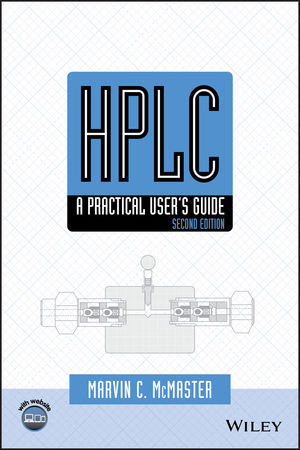HPLC: A Practical User's Guide, 2nd EditionISBN: 978-0-471-75401-5
Hardcover
256 pages
December 2006
 This is a Print-on-Demand title. It will be printed specifically to fill your order. Please allow an additional 10-15 days delivery time. The book is not returnable.
|
||||||
Preface xi
I HPLC Primer 1
1 Advantages and Disadvantages of HPLC 3
1.1 How It Works 4
1.1.1 A Separation Model of the Column 5
1.1.2 Basic Hardware: A Quick, First Look 7
1.1.3 Use of Solvent Gradients 8
1.1.4 Ranges of Compounds 9
1.2 Other Ways to Make My Separation 9
1.2.1 FPLC—Fast Protein Liquid Chromatography 10
1.2.2 LC—Traditional Liquid Chromatography 10
1.2.3 GLC—Gas Liquid Chromatography 11
1.2.4 SFC—Supercritical Fluid Chromatography 11
1.2.5 TLC—Thin Layer Chromatography 12
1.2.6 EP—Electrophoresis 12
1.2.7 CZE—Capillary Zone Electrophoresis 13
2 Selecting an HPLC System 15
2.1 Characteristic Systems 16
2.1.1 Finding a Fit: Detectors and Data Processing 16
2.1.2 System Models: Gradient Versus Isocratic 16
2.1.3 Vendor Selection 17
2.1.4 Brand Names and Clones 17
2.1.5 Hardware–Service–Support 18
2.2 System Cost Estimates 19
2.2.1 Type I System—QC Isocratic (Cost: $10–15,000) 19
2.2.2 Type II System—Research Gradient (Cost: $20–25,000) 19
2.2.3 Type III System—Automated Clinical (Cost: $25–35,000) 20
2.2.4 Type IV System—Automated Methods (Cost: $30–50,000) 21
2.3 Columns 21
2.3.1 Sizes: Analytical and Preparative 21
2.3.2 Separating Modes: Selecting Only What You Need 22
2.3.3 Tips on Column Use 23
3 Running Your Chromatograph 25
3.1 Set-up and Start-up 25
3.1.1 Hardware Plumbing 101: Tubing and Fittings 26
3.1.2 Connecting Components 28
3.1.3 Solvent Clean-up 30
3.1.4 Water Purity Test 33
3.1.5 Start-up System Flushing 34
3.1.6 Column Preparation and Equilibration 35
3.2 Sample Preparation and Column Calibration 36
3.2.1 Sample Clean-up 36
3.2.2 Plate Counts 37
3.3 Your First Chromatogram 37
3.3.1 Reproducible Injection Techniques 38
3.3.2 Simple Scouting for a Mobile Phase 39
3.3.3 Examining the Chromatogram 40
3.3.4 Basic Calculations of Results 41
II HPLC Optimization 43
4 Separation Models 45
4.1 Partition 45
4.1.1 Separation Parameters 48
4.1.2 Efficiency Factor 49
4.1.3 Separation (Chemistry) Factor 53
4.2 Ion Exchange Chromatography 56
4.3 Size Exclusion Chromatography 57
4.4 Affinity Chromatography 59
5 Column Preparation 61
5.1 Column Variations 61
5.2 Packing Materials and Hardware 64
5.3 Column Selection 66
6 Column Aging, Diagnosis, and Healing 73
6.1 Packing Degrading—Bonded-Phase Loss 74
6.2 Dissolved Packing Material—End Voids 77
6.3 Bound Material 78
6.4 Pressure Increases 81
6.5 Column Channeling—Center-Voids 83
6.6 Normal Phase, Ion Exchange, and Size Columns 84
6.7 Zirconium and Polymer Columns 86
7 Partition Chromatography Modifications 89
7.1 Reverse-Phase and Hybrid Silica 89
7.1.1 Ionization Suppression 90
7.1.2 Ion Pairing 91
7.1.3 Organic Modifiers 92
7.1.4 Chelation 92
7.2 Acidic Phase Silica 93
7.3 Reverse-Phase Zirconium 93
7.4 Partition Mode Selection 94
8 “Nonpartition” Chromatography 95
8.1 Ion Exchange 96
8.1.1 Cationic: Weak and Strong 96
8.1.2 Anionic: Weak and Strong 97
8.2 Size Exclusion 98
8.2.1 Organic Soluble Samples 98
8.2.2 Hydrophilic Protein Separation 99
8.3 Affinity Chromatography 101
8.3.1 Column Packing Modification 102
8.3.2 Chelation and Optically Active Columns 103
9 Hardware Specifics 105
9.1 System Protection 105
9.1.1 Filters, Guard Columns, and Saturation Columns 106
9.1.2 Inert Surfaces and Connections 107
9.2 Pumping 108
9.2.1 High- and Low-Pressure Mixing Controllers 109
9.2.2 Checking Gradient Performance 112
9.3 Injectors and Autosamplers 113
9.4 Detectors 116
9.4.1 Mass Dependent Detectors 116
9.4.2 Absorptive Detectors 119
9.4.3 Specific Detectors 122
9.5 Fraction Collectors 123
9.6 Data Collection and Processing 123
10 Troubleshooting and Optimization 125
10.1 Hardware and Tools—System Pacification 125
10.2 Reverse Order Diagnosis 129
10.3 Introduction to Data Acquisition 132
10.4 Solvent Conservation 133
III HPLC Utilization 135
11 Preparative Chromatography 137
11.1 Analytical Preparative 138
11.2 Semipreparative 139
11.3 “True” Preparative 139
12 Sample Preparation and Methods Development 143
12.1 Sample Preparation 143
12.1.1 Deproteination 144
12.1.2 Extraction and Concentration 145
12.1.3 SFE (Cartridge Column) Preparations 145
12.1.4 Extracting Encapsulated Compounds 147
12.1.5 SFE Trace Enrichment and Windowing 148
12.1.6 Derivatives 151
12.2 Methods Development 151
12.2.1 Standards Development 152
12.2.2 Samples Development 154
12.3 Gradient Development 156
13 Application Logics: Separations Overview 159
13.1 Fat-Soluble Vitamins, Steroid, and Lipids 159
13.2 Water-Soluble Vitamins, Carbohydrates, and Acids 160
13.3 Nucleomics 161
13.4 Proteomics 162
13.5 Clinical and Forensic Drug Monitoring 163
13.6 Pharmaceutical Drug Development 164
13.7 Environmental and Reaction Monitoring 164
13.8 Application Trends 165
14 Automation 167
14.1 Analog-to-Digital Interfacing 167
14.2 Digital Information Exchange 169
14.3 HPLC System Control and Automation 169
14.4 Data Collection and Interpretation 170
14.4.1 Preinjection Baseline Setting 171
14.4.2 Peak Detection and Integration 171
14.4.3 Quantitation: Internal/External Standards 172
14.5 Automated Methods Development 172
14.5.1 Automated Isocratic Development 173
14.5.2 Hinge Point Gradient Development 176
14.6 Data Exportation to the Real World 177
14.6.1 Word Processors: .ASC, .DOC, .RTF, .WS, .WP Formats 177
14.6.2 Spread Sheets: .DIF, .WK, .XLS Formats 178
14.6.3 Databases: .DB2 Format 178
14.6.4 Graphics: .PCX, .TIFF, .JPG Formats 178
14.6.5 Chromatographic Files: Metafiles and NetCDF 178
15 Recent Advances in LC/MS Separations 181
15.1 A LC/MS Primer 181
15.1.1 Quadrupole MS and Mass Selection 183
15.1.2 Other Types of MS Analyzers for LC/MS 185
15.1.3 LC/MS Interfaces 187
15.1.4 LC/MS Computer Control and Data Processing 189
15.2 Microflow Chromatography 191
15.3 Ultrafast HPLC Systems 192
15.4 Chip HPLC Systems 192
15.5 Standardized LC/MS in Drug Design 193
16 New Directions in HPLC 195
16.1 Temperature-Controlled Chromatography 195
16.2 Ultrafast Chromatography 196
16.3 Monolith Capillary Columns 196
16.4 Micro-Parallel HPLC Systems 197
16.5 Two-Dimensional HPLC Systems 197
16.6 The Portable LC/MS 198
Appendices 201
Appendix A Personal Separations Guide 203
Appendix B FAQs for HPLC Systems and Columns 205
Appendix C Tables of Solvents and Volatile Buffers 211
Appendix D Glossary of HPLC Terms 213
Appendix E HPLC Troubleshooting Quick Reference 221
Appendix F HPLC Laboratory Experiments 227
Laboratory 1—System Start-up and Column Quality Control 227
Laboratory 2—Sample Preparation and Methods Development 229
Laboratory 3—Column and Solvent Switching and Pacification 231
Appendix G Selected Reference List 233
Index 235



